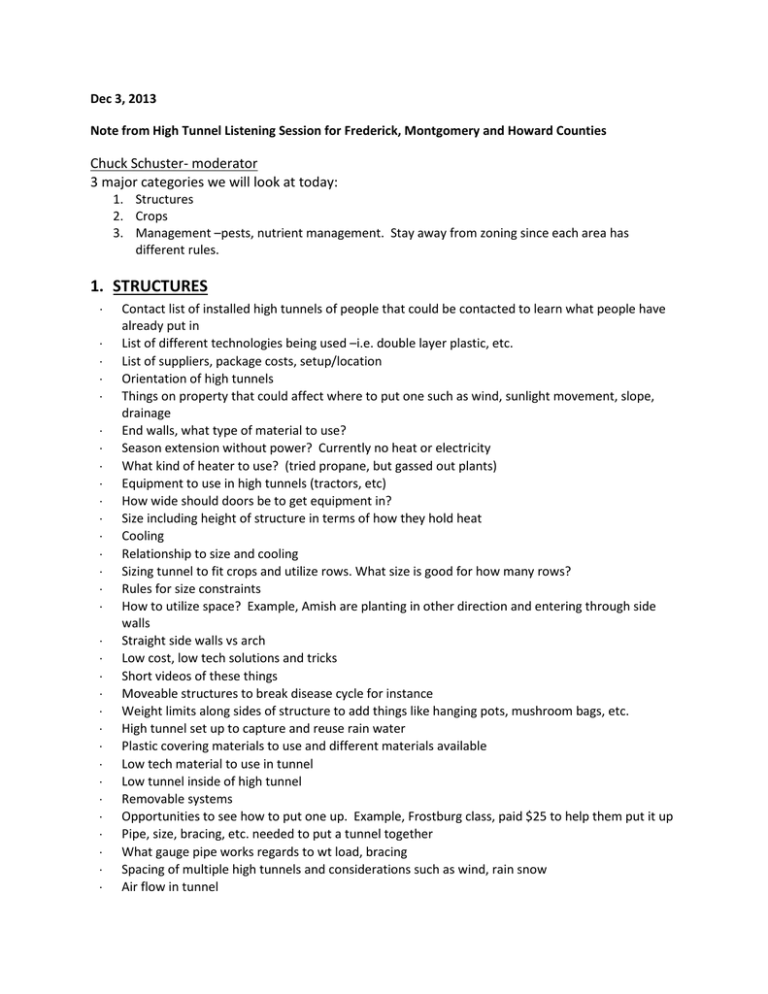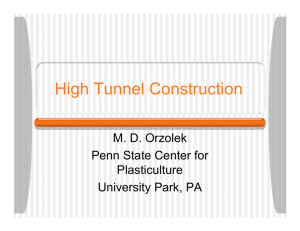Chuck Schuster- moderator 3 major categories we will look at today:
advertisement

Dec 3, 2013 Note from High Tunnel Listening Session for Frederick, Montgomery and Howard Counties Chuck Schuster- moderator 3 major categories we will look at today: 1. Structures 2. Crops 3. Management –pests, nutrient management. Stay away from zoning since each area has different rules. 1. STRUCTURES ⋅ ⋅ ⋅ ⋅ ⋅ ⋅ ⋅ ⋅ ⋅ ⋅ ⋅ ⋅ ⋅ ⋅ ⋅ ⋅ ⋅ ⋅ ⋅ ⋅ ⋅ ⋅ ⋅ ⋅ ⋅ ⋅ ⋅ ⋅ ⋅ ⋅ ⋅ Contact list of installed high tunnels of people that could be contacted to learn what people have already put in List of different technologies being used –i.e. double layer plastic, etc. List of suppliers, package costs, setup/location Orientation of high tunnels Things on property that could affect where to put one such as wind, sunlight movement, slope, drainage End walls, what type of material to use? Season extension without power? Currently no heat or electricity What kind of heater to use? (tried propane, but gassed out plants) Equipment to use in high tunnels (tractors, etc) How wide should doors be to get equipment in? Size including height of structure in terms of how they hold heat Cooling Relationship to size and cooling Sizing tunnel to fit crops and utilize rows. What size is good for how many rows? Rules for size constraints How to utilize space? Example, Amish are planting in other direction and entering through side walls Straight side walls vs arch Low cost, low tech solutions and tricks Short videos of these things Moveable structures to break disease cycle for instance Weight limits along sides of structure to add things like hanging pots, mushroom bags, etc. High tunnel set up to capture and reuse rain water Plastic covering materials to use and different materials available Low tech material to use in tunnel Low tunnel inside of high tunnel Removable systems Opportunities to see how to put one up. Example, Frostburg class, paid $25 to help them put it up Pipe, size, bracing, etc. needed to put a tunnel together What gauge pipe works regards to wt load, bracing Spacing of multiple high tunnels and considerations such as wind, rain snow Air flow in tunnel 2. CROPS ⋅ ⋅ ⋅ ⋅ ⋅ ⋅ ⋅ ⋅ ⋅ ⋅ ⋅ ⋅ ⋅ ⋅ ⋅ ⋅ ⋅ ⋅ Raised beds vs plants directly in soil Support for plants, rock beds etc Temperature constraints Spacing Size constraints Soil and amendments to keep productivity high Regional crop planting dates and cultivars Plant varieties that work best and are high quality in terms of flavor and texture Heirloom tomatoes that can take high temperature? Flowers in high tunnels Ornamentals Specialty crops, ethnic markets Alternative crops –herbs, ginger, essential oils, etc. What plants are most financially productive? Plants from seeds (seed mats) and transplanting Rotation Pest and disease pressure Methods of supporting crops -cages, strings, clips for tomatoes, what you can attach to cross bars, etc. List of what people in area are growing in their tunnels? Different growing methods Containers things to grow crops in, baskets, buckets, raised beds, gutters? Tricks for summer production (Rob) Pollination (not a big concern) No one seemed to be growing strawberries Crop schedule management Cover crops and appropriate cover crops – (someone said they are trying Rye for the first time) Cover crop cost share? Combine acreage of crops in and out of tunnel Timing of cover crops (Dicot radish for example early date) Intercropping and trying to utilize dollar per sq. ft. Getting the most out of every inch Labor time management to keep high tunnel running smoothly ⋅ ⋅ ⋅ ⋅ ⋅ ⋅ ⋅ ⋅ ⋅ ⋅ ⋅ ⋅ 3. Management ⋅ ⋅ ⋅ ⋅ ⋅ ⋅ IPM, (integrated pest Management) Pest management and what can be used in a tunnel vs. out Delivery methods for pesticides Soil management ⋅ Drainage and how to deal with soil that does not want to drain ⋅ Optimum soil moisture and temperature for controlling insects and disease cycles ⋅ Soil amendments ⋅ Nutrient management ⋅ Moisture management Soil health down the road. Letting soil rest Air flow ⋅ ⋅ ⋅ ⋅ ⋅ ⋅ ⋅ ⋅ ⋅ ⋅ ⋅ ⋅ ⋅ ⋅ ⋅ Wildlife management How do things differ inside tunnel vs. outside? Veg handbook, (UME) most of the recommendations are for outside, not in a high tunnel, in the book. (Chuck, book is already at the printers this year. Good idea for next year to share with people putting crop recommendations together). Things you can do to alleviate salt and fertility increases. Example, large radishes like dicot can take up to 150-300lbs of nitrogen out of your soil per acres. Nitrogen in soil is not regulated yet, but it may become an issue in the future. Fertility management program Tillage methods and no till Cost of input vs. output of different vegetables and crops. Cost vs. potential returns. Partial budget - not talking about heating and water costs Market Irrigation systems, injectors Haygrove tunnels, 3 season structures Overall management, 1 tunnel vs multiple tunnels through cost sharing Crop mix and what to grow in low and high tunnels Mid Atlantic fruit and vegetable conventions –Hersey Park Fruit trees and beneficial insects (note: not much interest in fruit trees at listening session) Rob –USDA Compass


